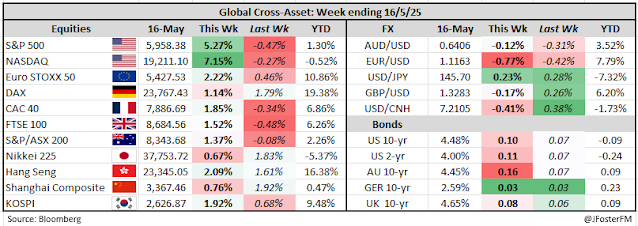A 90-day truce on severe trade tariffs between the US and China helped unlock large gains for US equity markets this week and remove some of the risk premium traders have embedded into the US dollar. Both sides have agreed to reduce tariffs on each other's imports by 115% - the tariff rate imposed by the US falling to 30% and China's to 10% - creating a positive backdrop for risk sentiment. With expectations for Fed easing turning less dovish on an improved economic outlook, Treasury yields were left to rise as the focus returned to deficit concerns - a move reinforced by the news on Friday of a ratings downgrade from Moody's.
Tariff-related volatility saw markets taking a string of softer-than-expected data prints in the US this week as more noise than signal. Inflationary pressures were yet to show any notable tariff effects. Headline CPI in April eased from 2.4% to 2.3%yr (vs 2.4%) and the core rate was steady at 2.8%yr (on consensus). Meanwhile, producer prices softened to 2.4% (vs 2.5%) from 2.7%yr, implying that pipeline price pressures were limited at this stage. On the consumer front, retail sales were soft in April after surging higher in March to front run tariffs. Retail sales slowed to a 0.1% rise in April from a 1.7% gain in March while the control group - a better gauge of the spending pulse - fell 0.2% from a 0.5% lift last time out.
In the UK, economic growth in the March quarter came through 0.7%q/q and 1.3%Y/Y pace, slightly upbeat relative to expectations. Tariff-related distortions did appear to be evident: business investment (2.9%q/q) and exports (3.5%q/q) clocked their fastest quarterly rises in at least 2 years, accelerated activity indicative of tariff frontrunning. The sizeable tax hike on employers in April has not appeared to dent the labour market. Although the estimated unemployment rate ticked up from 4.4% to 4.5%, employment lifted by 112k over the past 3 months. Wage pressures have also cooled, easing to a 5.6%yr pace from 5.9% previously.
Upside surprises in the latest data for wages growth and employment has not shifted markets from pricing in a 25bps RBA rate cut next week followed by two more cuts before year-end. Although well into the post-pandemic cycle, Australia's labour market continues to deliver robust outcomes. Wages growth firmed from 3.2% to a 3.4% annual pace in the March quarter (see here), while employment surged by 89k in April - its strongest rise in 14 months - keeping the unemployment rate low and steady at 4.1% as participation rebounded to a near record high of 67.1% (see here). Labour market strength could be used by the Board as justification to leave rates on hold, but the sense is that it will give more weight to the ongoing progress on the inflation side of its mandate. Core inflation returned to the 2-3% target band in the March quarter for the first time since 2021, a factor that should guide the Board towards continuing the process it started back in February of gradually loosening monetary policy.

